University of Kansas Statistics Homework: Normal Approximation and CLT
VerifiedAdded on 2022/09/03
|10
|2097
|17
Homework Assignment
AI Summary
This document provides detailed solutions to a statistics homework assignment, likely for an introductory statistics course at the University of Kansas, Spring 2019. The solutions cover several key statistical concepts, including the normal approximation to the binomial distribution, the central limit theorem (CLT), and the distribution of the sample proportion. The problems involve calculating probabilities using z-scores, means, and standard deviations, and applying these concepts to various scenarios. Specific examples address customer visit percentages, sample means, and sample proportions, demonstrating how to apply statistical methods to real-world situations. The solutions are presented step-by-step, making it easier for students to understand the methodology and calculations involved in each problem. The document serves as a valuable resource for students seeking to understand and solve similar statistics problems.
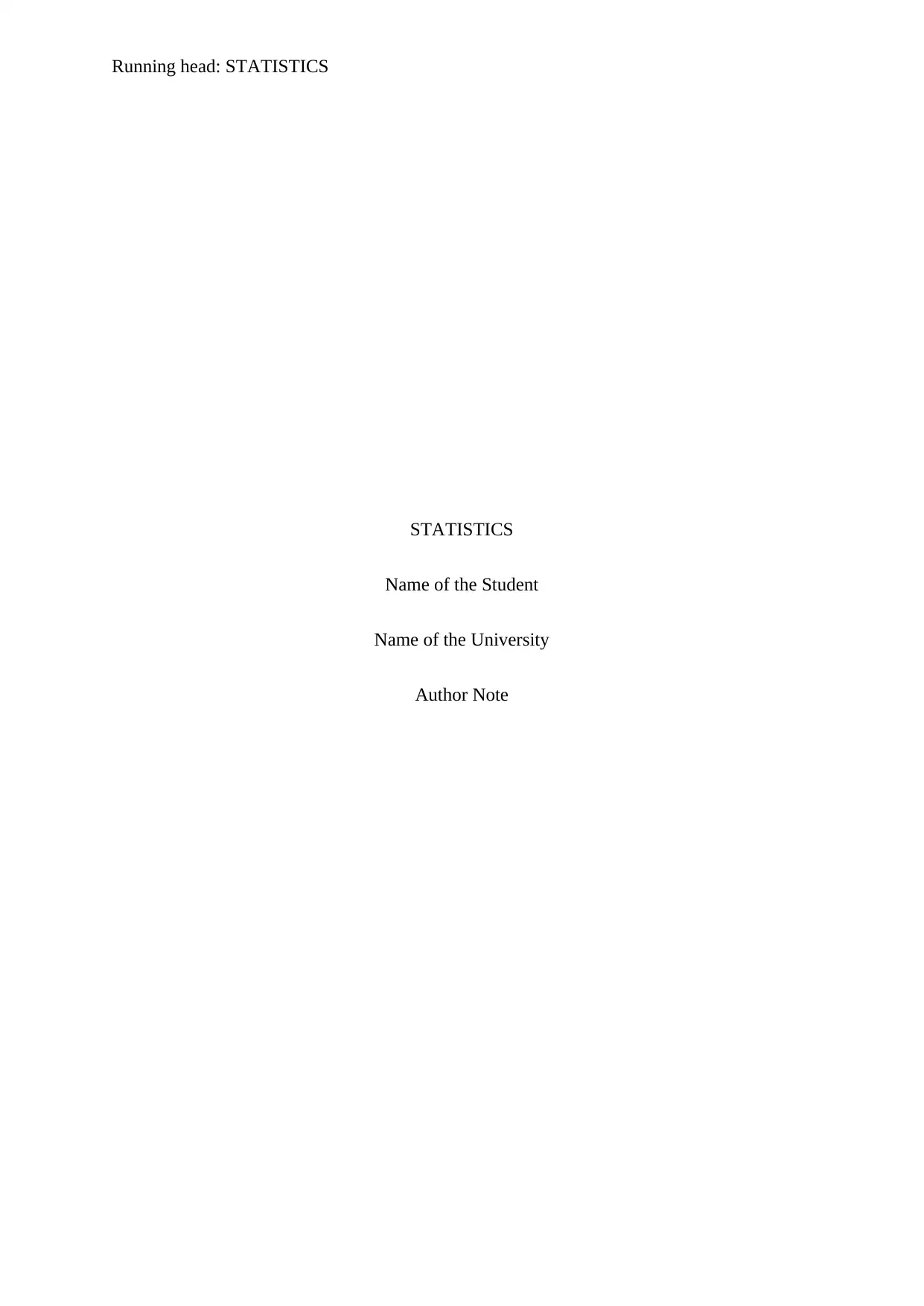
Running head: STATISTICS
STATISTICS
Name of the Student
Name of the University
Author Note
STATISTICS
Name of the Student
Name of the University
Author Note
Paraphrase This Document
Need a fresh take? Get an instant paraphrase of this document with our AI Paraphraser
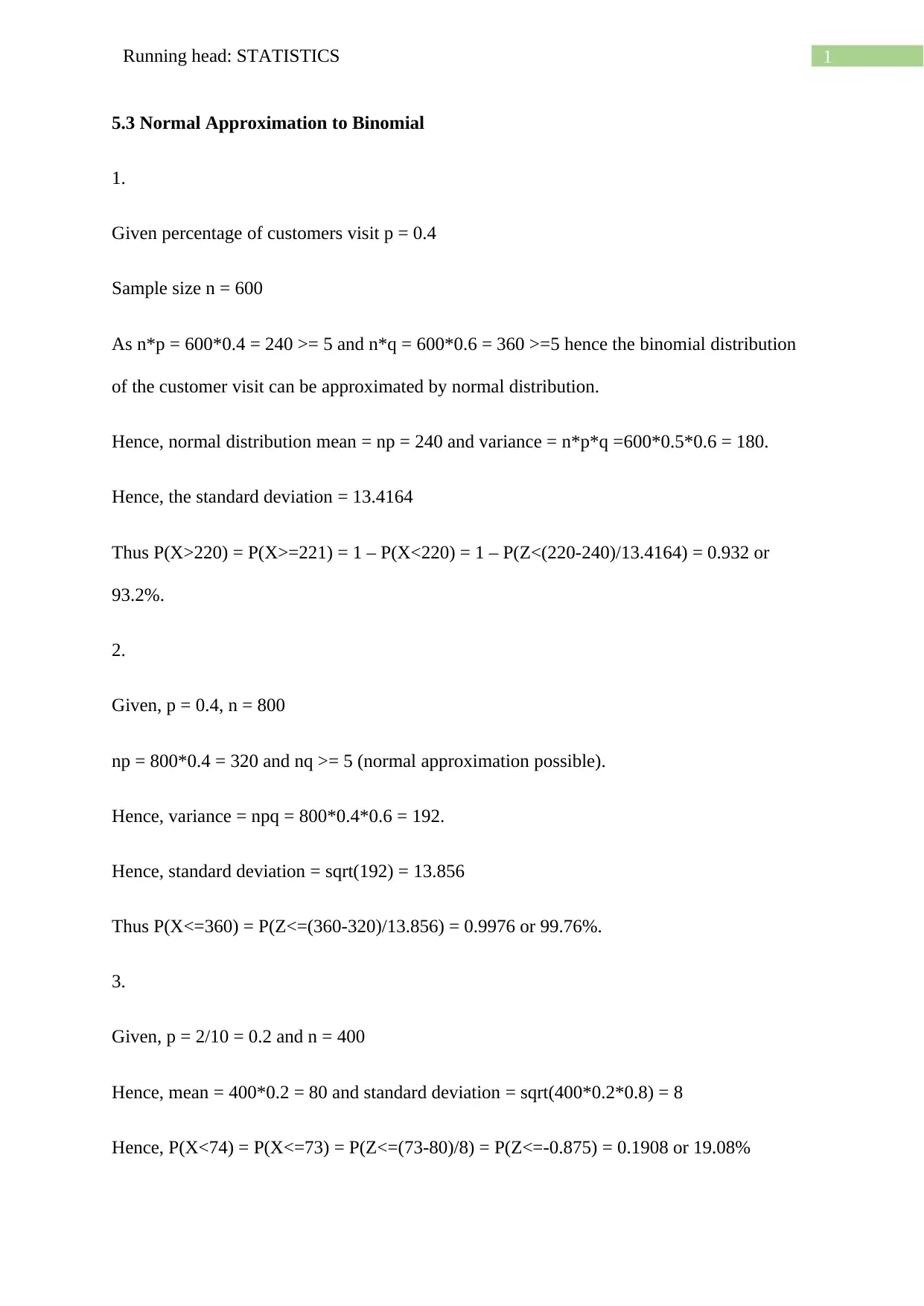
1Running head: STATISTICS
5.3 Normal Approximation to Binomial
1.
Given percentage of customers visit p = 0.4
Sample size n = 600
As n*p = 600*0.4 = 240 >= 5 and n*q = 600*0.6 = 360 >=5 hence the binomial distribution
of the customer visit can be approximated by normal distribution.
Hence, normal distribution mean = np = 240 and variance = n*p*q =600*0.5*0.6 = 180.
Hence, the standard deviation = 13.4164
Thus P(X>220) = P(X>=221) = 1 – P(X<220) = 1 – P(Z<(220-240)/13.4164) = 0.932 or
93.2%.
2.
Given, p = 0.4, n = 800
np = 800*0.4 = 320 and nq >= 5 (normal approximation possible).
Hence, variance = npq = 800*0.4*0.6 = 192.
Hence, standard deviation = sqrt(192) = 13.856
Thus P(X<=360) = P(Z<=(360-320)/13.856) = 0.9976 or 99.76%.
3.
Given, p = 2/10 = 0.2 and n = 400
Hence, mean = 400*0.2 = 80 and standard deviation = sqrt(400*0.2*0.8) = 8
Hence, P(X<74) = P(X<=73) = P(Z<=(73-80)/8) = P(Z<=-0.875) = 0.1908 or 19.08%
5.3 Normal Approximation to Binomial
1.
Given percentage of customers visit p = 0.4
Sample size n = 600
As n*p = 600*0.4 = 240 >= 5 and n*q = 600*0.6 = 360 >=5 hence the binomial distribution
of the customer visit can be approximated by normal distribution.
Hence, normal distribution mean = np = 240 and variance = n*p*q =600*0.5*0.6 = 180.
Hence, the standard deviation = 13.4164
Thus P(X>220) = P(X>=221) = 1 – P(X<220) = 1 – P(Z<(220-240)/13.4164) = 0.932 or
93.2%.
2.
Given, p = 0.4, n = 800
np = 800*0.4 = 320 and nq >= 5 (normal approximation possible).
Hence, variance = npq = 800*0.4*0.6 = 192.
Hence, standard deviation = sqrt(192) = 13.856
Thus P(X<=360) = P(Z<=(360-320)/13.856) = 0.9976 or 99.76%.
3.
Given, p = 2/10 = 0.2 and n = 400
Hence, mean = 400*0.2 = 80 and standard deviation = sqrt(400*0.2*0.8) = 8
Hence, P(X<74) = P(X<=73) = P(Z<=(73-80)/8) = P(Z<=-0.875) = 0.1908 or 19.08%
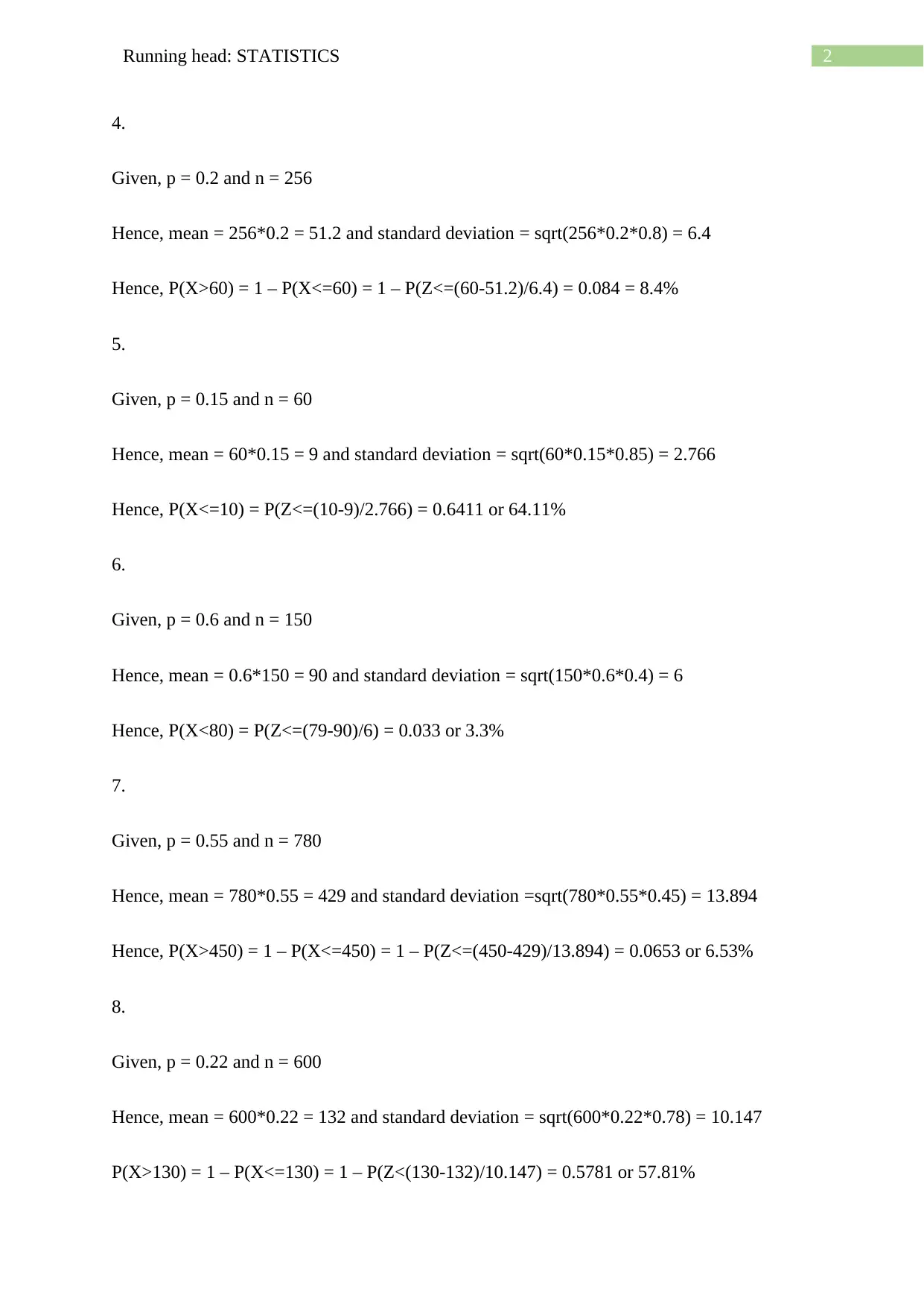
2Running head: STATISTICS
4.
Given, p = 0.2 and n = 256
Hence, mean = 256*0.2 = 51.2 and standard deviation = sqrt(256*0.2*0.8) = 6.4
Hence, P(X>60) = 1 – P(X<=60) = 1 – P(Z<=(60-51.2)/6.4) = 0.084 = 8.4%
5.
Given, p = 0.15 and n = 60
Hence, mean = 60*0.15 = 9 and standard deviation = sqrt(60*0.15*0.85) = 2.766
Hence, P(X<=10) = P(Z<=(10-9)/2.766) = 0.6411 or 64.11%
6.
Given, p = 0.6 and n = 150
Hence, mean = 0.6*150 = 90 and standard deviation = sqrt(150*0.6*0.4) = 6
Hence, P(X<80) = P(Z<=(79-90)/6) = 0.033 or 3.3%
7.
Given, p = 0.55 and n = 780
Hence, mean = 780*0.55 = 429 and standard deviation =sqrt(780*0.55*0.45) = 13.894
Hence, P(X>450) = 1 – P(X<=450) = 1 – P(Z<=(450-429)/13.894) = 0.0653 or 6.53%
8.
Given, p = 0.22 and n = 600
Hence, mean = 600*0.22 = 132 and standard deviation = sqrt(600*0.22*0.78) = 10.147
P(X>130) = 1 – P(X<=130) = 1 – P(Z<(130-132)/10.147) = 0.5781 or 57.81%
4.
Given, p = 0.2 and n = 256
Hence, mean = 256*0.2 = 51.2 and standard deviation = sqrt(256*0.2*0.8) = 6.4
Hence, P(X>60) = 1 – P(X<=60) = 1 – P(Z<=(60-51.2)/6.4) = 0.084 = 8.4%
5.
Given, p = 0.15 and n = 60
Hence, mean = 60*0.15 = 9 and standard deviation = sqrt(60*0.15*0.85) = 2.766
Hence, P(X<=10) = P(Z<=(10-9)/2.766) = 0.6411 or 64.11%
6.
Given, p = 0.6 and n = 150
Hence, mean = 0.6*150 = 90 and standard deviation = sqrt(150*0.6*0.4) = 6
Hence, P(X<80) = P(Z<=(79-90)/6) = 0.033 or 3.3%
7.
Given, p = 0.55 and n = 780
Hence, mean = 780*0.55 = 429 and standard deviation =sqrt(780*0.55*0.45) = 13.894
Hence, P(X>450) = 1 – P(X<=450) = 1 – P(Z<=(450-429)/13.894) = 0.0653 or 6.53%
8.
Given, p = 0.22 and n = 600
Hence, mean = 600*0.22 = 132 and standard deviation = sqrt(600*0.22*0.78) = 10.147
P(X>130) = 1 – P(X<=130) = 1 – P(Z<(130-132)/10.147) = 0.5781 or 57.81%
⊘ This is a preview!⊘
Do you want full access?
Subscribe today to unlock all pages.

Trusted by 1+ million students worldwide
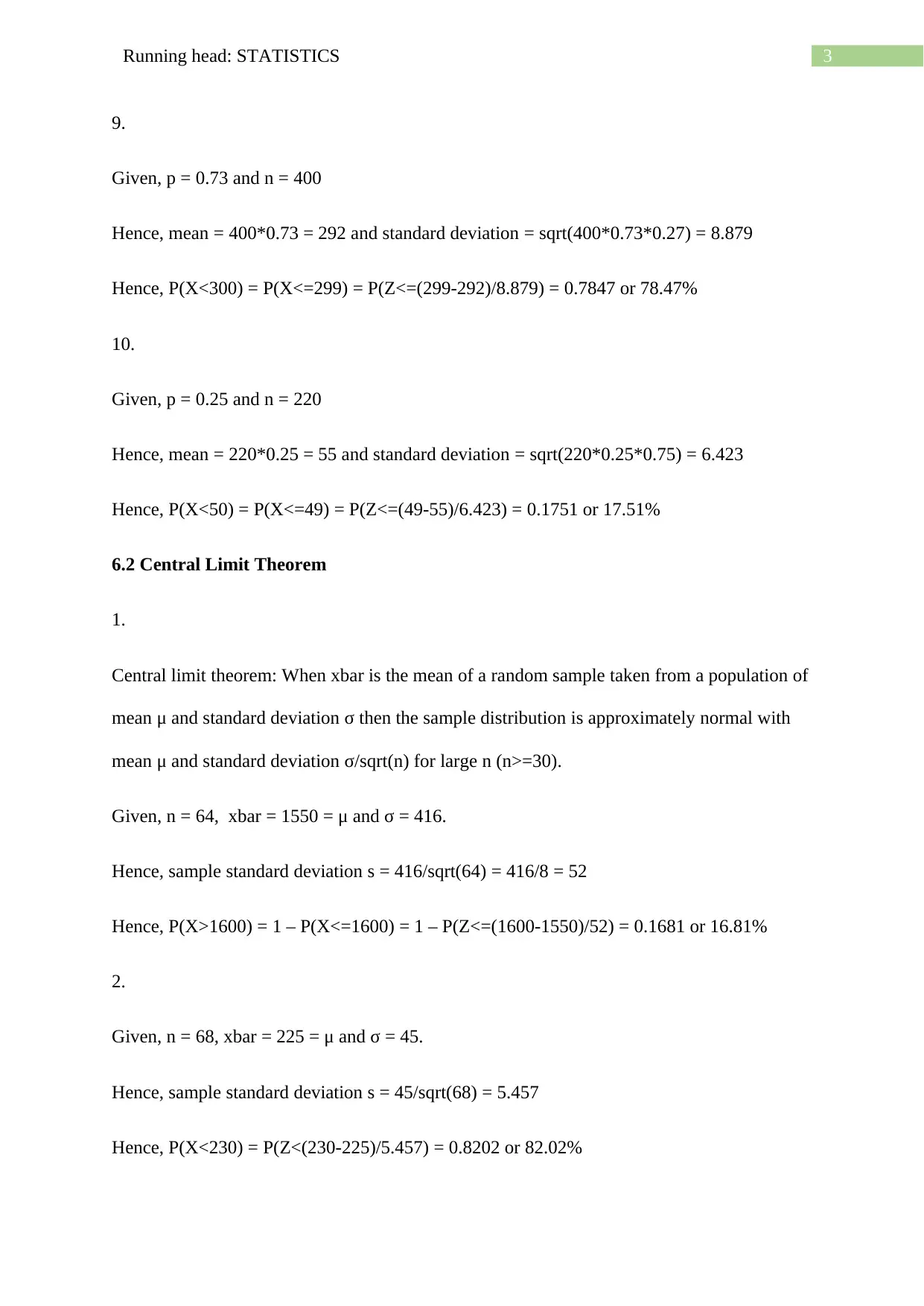
3Running head: STATISTICS
9.
Given, p = 0.73 and n = 400
Hence, mean = 400*0.73 = 292 and standard deviation = sqrt(400*0.73*0.27) = 8.879
Hence, P(X<300) = P(X<=299) = P(Z<=(299-292)/8.879) = 0.7847 or 78.47%
10.
Given, p = 0.25 and n = 220
Hence, mean = 220*0.25 = 55 and standard deviation = sqrt(220*0.25*0.75) = 6.423
Hence, P(X<50) = P(X<=49) = P(Z<=(49-55)/6.423) = 0.1751 or 17.51%
6.2 Central Limit Theorem
1.
Central limit theorem: When xbar is the mean of a random sample taken from a population of
mean μ and standard deviation σ then the sample distribution is approximately normal with
mean μ and standard deviation σ/sqrt(n) for large n (n>=30).
Given, n = 64, xbar = 1550 = μ and σ = 416.
Hence, sample standard deviation s = 416/sqrt(64) = 416/8 = 52
Hence, P(X>1600) = 1 – P(X<=1600) = 1 – P(Z<=(1600-1550)/52) = 0.1681 or 16.81%
2.
Given, n = 68, xbar = 225 = μ and σ = 45.
Hence, sample standard deviation s = 45/sqrt(68) = 5.457
Hence, P(X<230) = P(Z<(230-225)/5.457) = 0.8202 or 82.02%
9.
Given, p = 0.73 and n = 400
Hence, mean = 400*0.73 = 292 and standard deviation = sqrt(400*0.73*0.27) = 8.879
Hence, P(X<300) = P(X<=299) = P(Z<=(299-292)/8.879) = 0.7847 or 78.47%
10.
Given, p = 0.25 and n = 220
Hence, mean = 220*0.25 = 55 and standard deviation = sqrt(220*0.25*0.75) = 6.423
Hence, P(X<50) = P(X<=49) = P(Z<=(49-55)/6.423) = 0.1751 or 17.51%
6.2 Central Limit Theorem
1.
Central limit theorem: When xbar is the mean of a random sample taken from a population of
mean μ and standard deviation σ then the sample distribution is approximately normal with
mean μ and standard deviation σ/sqrt(n) for large n (n>=30).
Given, n = 64, xbar = 1550 = μ and σ = 416.
Hence, sample standard deviation s = 416/sqrt(64) = 416/8 = 52
Hence, P(X>1600) = 1 – P(X<=1600) = 1 – P(Z<=(1600-1550)/52) = 0.1681 or 16.81%
2.
Given, n = 68, xbar = 225 = μ and σ = 45.
Hence, sample standard deviation s = 45/sqrt(68) = 5.457
Hence, P(X<230) = P(Z<(230-225)/5.457) = 0.8202 or 82.02%
Paraphrase This Document
Need a fresh take? Get an instant paraphrase of this document with our AI Paraphraser
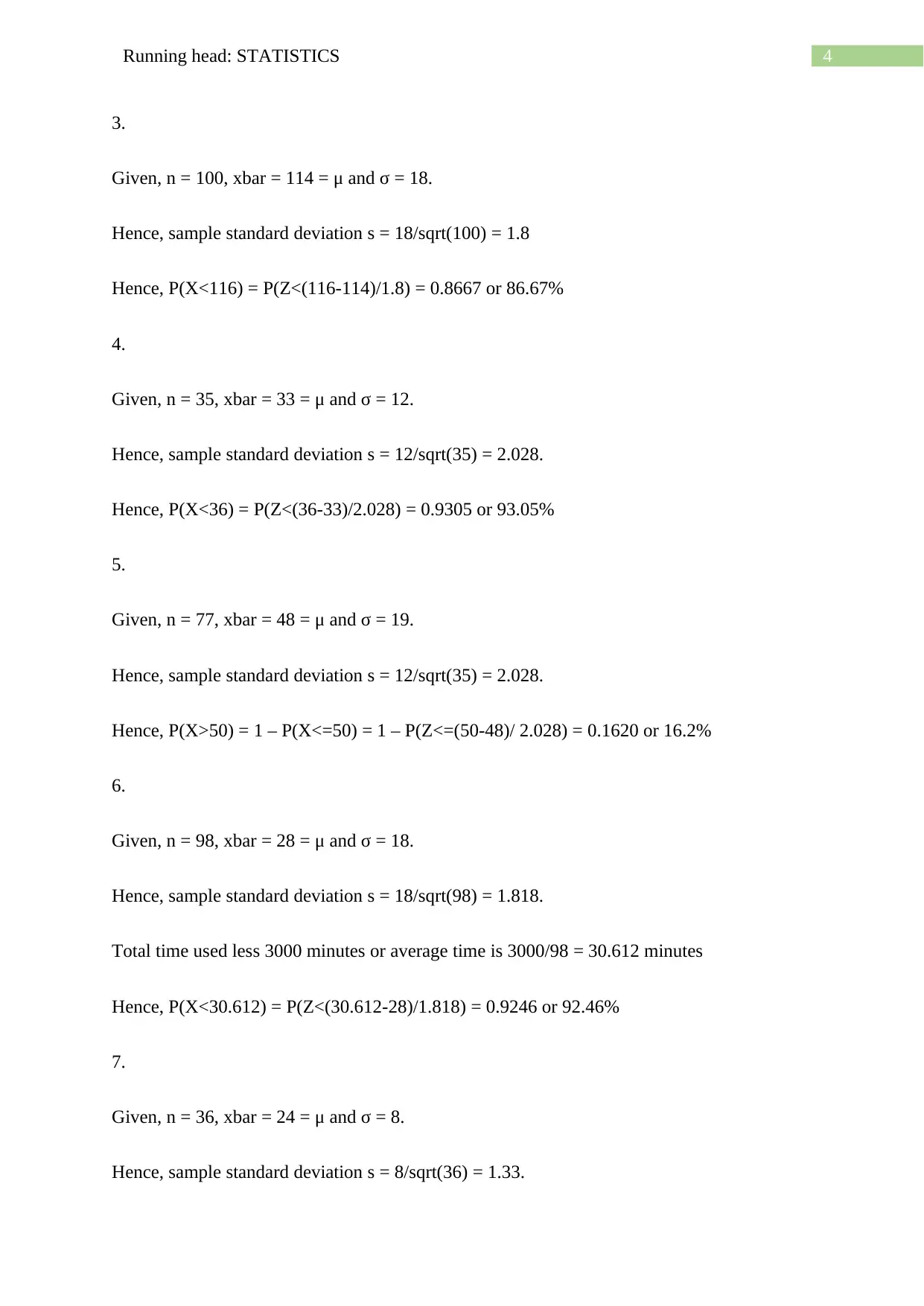
4Running head: STATISTICS
3.
Given, n = 100, xbar = 114 = μ and σ = 18.
Hence, sample standard deviation s = 18/sqrt(100) = 1.8
Hence, P(X<116) = P(Z<(116-114)/1.8) = 0.8667 or 86.67%
4.
Given, n = 35, xbar = 33 = μ and σ = 12.
Hence, sample standard deviation s = 12/sqrt(35) = 2.028.
Hence, P(X<36) = P(Z<(36-33)/2.028) = 0.9305 or 93.05%
5.
Given, n = 77, xbar = 48 = μ and σ = 19.
Hence, sample standard deviation s = 12/sqrt(35) = 2.028.
Hence, P(X>50) = 1 – P(X<=50) = 1 – P(Z<=(50-48)/ 2.028) = 0.1620 or 16.2%
6.
Given, n = 98, xbar = 28 = μ and σ = 18.
Hence, sample standard deviation s = 18/sqrt(98) = 1.818.
Total time used less 3000 minutes or average time is 3000/98 = 30.612 minutes
Hence, P(X<30.612) = P(Z<(30.612-28)/1.818) = 0.9246 or 92.46%
7.
Given, n = 36, xbar = 24 = μ and σ = 8.
Hence, sample standard deviation s = 8/sqrt(36) = 1.33.
3.
Given, n = 100, xbar = 114 = μ and σ = 18.
Hence, sample standard deviation s = 18/sqrt(100) = 1.8
Hence, P(X<116) = P(Z<(116-114)/1.8) = 0.8667 or 86.67%
4.
Given, n = 35, xbar = 33 = μ and σ = 12.
Hence, sample standard deviation s = 12/sqrt(35) = 2.028.
Hence, P(X<36) = P(Z<(36-33)/2.028) = 0.9305 or 93.05%
5.
Given, n = 77, xbar = 48 = μ and σ = 19.
Hence, sample standard deviation s = 12/sqrt(35) = 2.028.
Hence, P(X>50) = 1 – P(X<=50) = 1 – P(Z<=(50-48)/ 2.028) = 0.1620 or 16.2%
6.
Given, n = 98, xbar = 28 = μ and σ = 18.
Hence, sample standard deviation s = 18/sqrt(98) = 1.818.
Total time used less 3000 minutes or average time is 3000/98 = 30.612 minutes
Hence, P(X<30.612) = P(Z<(30.612-28)/1.818) = 0.9246 or 92.46%
7.
Given, n = 36, xbar = 24 = μ and σ = 8.
Hence, sample standard deviation s = 8/sqrt(36) = 1.33.
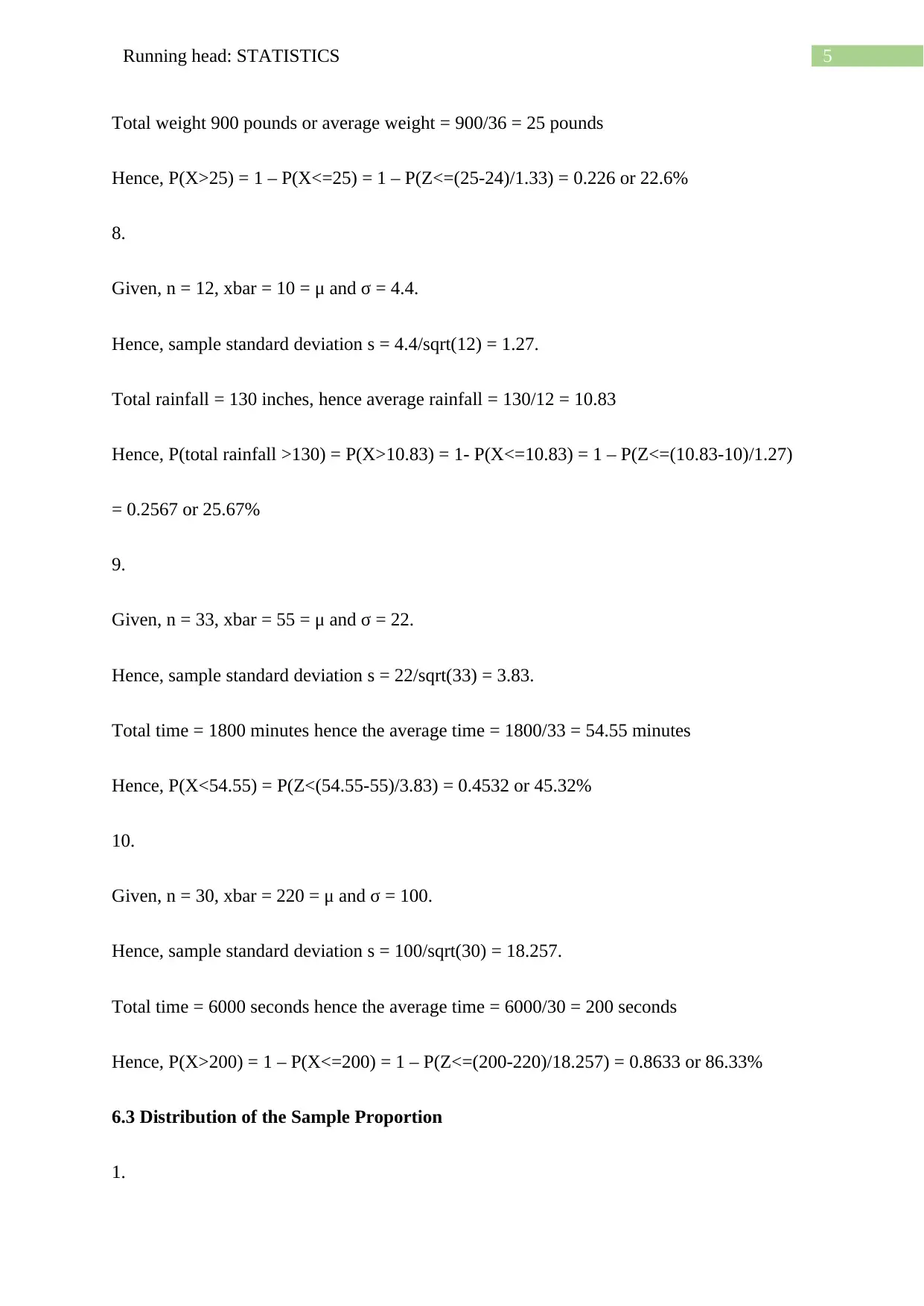
5Running head: STATISTICS
Total weight 900 pounds or average weight = 900/36 = 25 pounds
Hence, P(X>25) = 1 – P(X<=25) = 1 – P(Z<=(25-24)/1.33) = 0.226 or 22.6%
8.
Given, n = 12, xbar = 10 = μ and σ = 4.4.
Hence, sample standard deviation s = 4.4/sqrt(12) = 1.27.
Total rainfall = 130 inches, hence average rainfall = 130/12 = 10.83
Hence, P(total rainfall >130) = P(X>10.83) = 1- P(X<=10.83) = 1 – P(Z<=(10.83-10)/1.27)
= 0.2567 or 25.67%
9.
Given, n = 33, xbar = 55 = μ and σ = 22.
Hence, sample standard deviation s = 22/sqrt(33) = 3.83.
Total time = 1800 minutes hence the average time = 1800/33 = 54.55 minutes
Hence, P(X<54.55) = P(Z<(54.55-55)/3.83) = 0.4532 or 45.32%
10.
Given, n = 30, xbar = 220 = μ and σ = 100.
Hence, sample standard deviation s = 100/sqrt(30) = 18.257.
Total time = 6000 seconds hence the average time = 6000/30 = 200 seconds
Hence, P(X>200) = 1 – P(X<=200) = 1 – P(Z<=(200-220)/18.257) = 0.8633 or 86.33%
6.3 Distribution of the Sample Proportion
1.
Total weight 900 pounds or average weight = 900/36 = 25 pounds
Hence, P(X>25) = 1 – P(X<=25) = 1 – P(Z<=(25-24)/1.33) = 0.226 or 22.6%
8.
Given, n = 12, xbar = 10 = μ and σ = 4.4.
Hence, sample standard deviation s = 4.4/sqrt(12) = 1.27.
Total rainfall = 130 inches, hence average rainfall = 130/12 = 10.83
Hence, P(total rainfall >130) = P(X>10.83) = 1- P(X<=10.83) = 1 – P(Z<=(10.83-10)/1.27)
= 0.2567 or 25.67%
9.
Given, n = 33, xbar = 55 = μ and σ = 22.
Hence, sample standard deviation s = 22/sqrt(33) = 3.83.
Total time = 1800 minutes hence the average time = 1800/33 = 54.55 minutes
Hence, P(X<54.55) = P(Z<(54.55-55)/3.83) = 0.4532 or 45.32%
10.
Given, n = 30, xbar = 220 = μ and σ = 100.
Hence, sample standard deviation s = 100/sqrt(30) = 18.257.
Total time = 6000 seconds hence the average time = 6000/30 = 200 seconds
Hence, P(X>200) = 1 – P(X<=200) = 1 – P(Z<=(200-220)/18.257) = 0.8633 or 86.33%
6.3 Distribution of the Sample Proportion
1.
⊘ This is a preview!⊘
Do you want full access?
Subscribe today to unlock all pages.

Trusted by 1+ million students worldwide
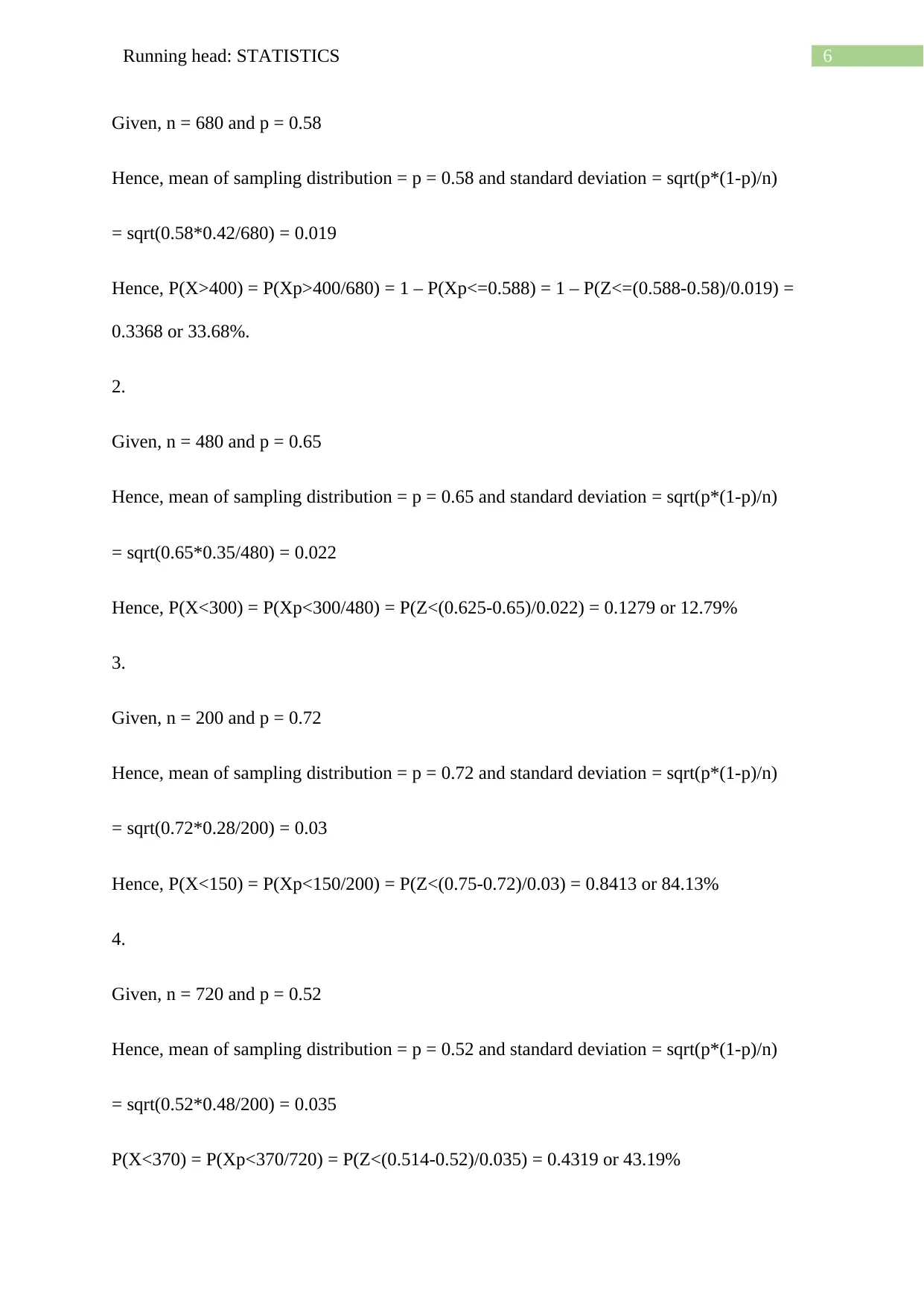
6Running head: STATISTICS
Given, n = 680 and p = 0.58
Hence, mean of sampling distribution = p = 0.58 and standard deviation = sqrt(p*(1-p)/n)
= sqrt(0.58*0.42/680) = 0.019
Hence, P(X>400) = P(Xp>400/680) = 1 – P(Xp<=0.588) = 1 – P(Z<=(0.588-0.58)/0.019) =
0.3368 or 33.68%.
2.
Given, n = 480 and p = 0.65
Hence, mean of sampling distribution = p = 0.65 and standard deviation = sqrt(p*(1-p)/n)
= sqrt(0.65*0.35/480) = 0.022
Hence, P(X<300) = P(Xp<300/480) = P(Z<(0.625-0.65)/0.022) = 0.1279 or 12.79%
3.
Given, n = 200 and p = 0.72
Hence, mean of sampling distribution = p = 0.72 and standard deviation = sqrt(p*(1-p)/n)
= sqrt(0.72*0.28/200) = 0.03
Hence, P(X<150) = P(Xp<150/200) = P(Z<(0.75-0.72)/0.03) = 0.8413 or 84.13%
4.
Given, n = 720 and p = 0.52
Hence, mean of sampling distribution = p = 0.52 and standard deviation = sqrt(p*(1-p)/n)
= sqrt(0.52*0.48/200) = 0.035
P(X<370) = P(Xp<370/720) = P(Z<(0.514-0.52)/0.035) = 0.4319 or 43.19%
Given, n = 680 and p = 0.58
Hence, mean of sampling distribution = p = 0.58 and standard deviation = sqrt(p*(1-p)/n)
= sqrt(0.58*0.42/680) = 0.019
Hence, P(X>400) = P(Xp>400/680) = 1 – P(Xp<=0.588) = 1 – P(Z<=(0.588-0.58)/0.019) =
0.3368 or 33.68%.
2.
Given, n = 480 and p = 0.65
Hence, mean of sampling distribution = p = 0.65 and standard deviation = sqrt(p*(1-p)/n)
= sqrt(0.65*0.35/480) = 0.022
Hence, P(X<300) = P(Xp<300/480) = P(Z<(0.625-0.65)/0.022) = 0.1279 or 12.79%
3.
Given, n = 200 and p = 0.72
Hence, mean of sampling distribution = p = 0.72 and standard deviation = sqrt(p*(1-p)/n)
= sqrt(0.72*0.28/200) = 0.03
Hence, P(X<150) = P(Xp<150/200) = P(Z<(0.75-0.72)/0.03) = 0.8413 or 84.13%
4.
Given, n = 720 and p = 0.52
Hence, mean of sampling distribution = p = 0.52 and standard deviation = sqrt(p*(1-p)/n)
= sqrt(0.52*0.48/200) = 0.035
P(X<370) = P(Xp<370/720) = P(Z<(0.514-0.52)/0.035) = 0.4319 or 43.19%
Paraphrase This Document
Need a fresh take? Get an instant paraphrase of this document with our AI Paraphraser
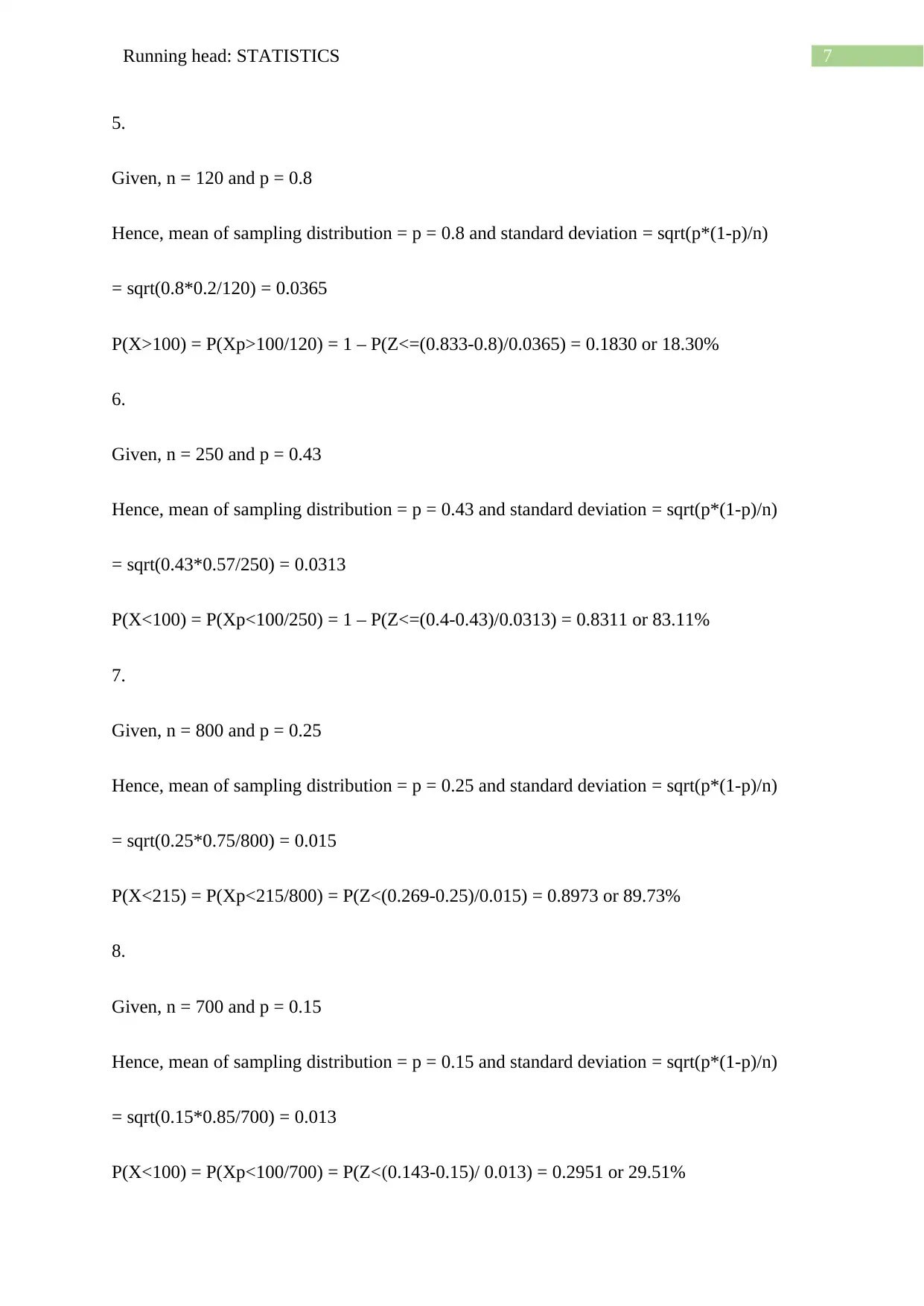
7Running head: STATISTICS
5.
Given, n = 120 and p = 0.8
Hence, mean of sampling distribution = p = 0.8 and standard deviation = sqrt(p*(1-p)/n)
= sqrt(0.8*0.2/120) = 0.0365
P(X>100) = P(Xp>100/120) = 1 – P(Z<=(0.833-0.8)/0.0365) = 0.1830 or 18.30%
6.
Given, n = 250 and p = 0.43
Hence, mean of sampling distribution = p = 0.43 and standard deviation = sqrt(p*(1-p)/n)
= sqrt(0.43*0.57/250) = 0.0313
P(X<100) = P(Xp<100/250) = 1 – P(Z<=(0.4-0.43)/0.0313) = 0.8311 or 83.11%
7.
Given, n = 800 and p = 0.25
Hence, mean of sampling distribution = p = 0.25 and standard deviation = sqrt(p*(1-p)/n)
= sqrt(0.25*0.75/800) = 0.015
P(X<215) = P(Xp<215/800) = P(Z<(0.269-0.25)/0.015) = 0.8973 or 89.73%
8.
Given, n = 700 and p = 0.15
Hence, mean of sampling distribution = p = 0.15 and standard deviation = sqrt(p*(1-p)/n)
= sqrt(0.15*0.85/700) = 0.013
P(X<100) = P(Xp<100/700) = P(Z<(0.143-0.15)/ 0.013) = 0.2951 or 29.51%
5.
Given, n = 120 and p = 0.8
Hence, mean of sampling distribution = p = 0.8 and standard deviation = sqrt(p*(1-p)/n)
= sqrt(0.8*0.2/120) = 0.0365
P(X>100) = P(Xp>100/120) = 1 – P(Z<=(0.833-0.8)/0.0365) = 0.1830 or 18.30%
6.
Given, n = 250 and p = 0.43
Hence, mean of sampling distribution = p = 0.43 and standard deviation = sqrt(p*(1-p)/n)
= sqrt(0.43*0.57/250) = 0.0313
P(X<100) = P(Xp<100/250) = 1 – P(Z<=(0.4-0.43)/0.0313) = 0.8311 or 83.11%
7.
Given, n = 800 and p = 0.25
Hence, mean of sampling distribution = p = 0.25 and standard deviation = sqrt(p*(1-p)/n)
= sqrt(0.25*0.75/800) = 0.015
P(X<215) = P(Xp<215/800) = P(Z<(0.269-0.25)/0.015) = 0.8973 or 89.73%
8.
Given, n = 700 and p = 0.15
Hence, mean of sampling distribution = p = 0.15 and standard deviation = sqrt(p*(1-p)/n)
= sqrt(0.15*0.85/700) = 0.013
P(X<100) = P(Xp<100/700) = P(Z<(0.143-0.15)/ 0.013) = 0.2951 or 29.51%

8Running head: STATISTICS
⊘ This is a preview!⊘
Do you want full access?
Subscribe today to unlock all pages.

Trusted by 1+ million students worldwide

9Running head: STATISTICS
1 out of 10
Related Documents
Your All-in-One AI-Powered Toolkit for Academic Success.
+13062052269
info@desklib.com
Available 24*7 on WhatsApp / Email
![[object Object]](/_next/static/media/star-bottom.7253800d.svg)
Unlock your academic potential
Copyright © 2020–2025 A2Z Services. All Rights Reserved. Developed and managed by ZUCOL.





